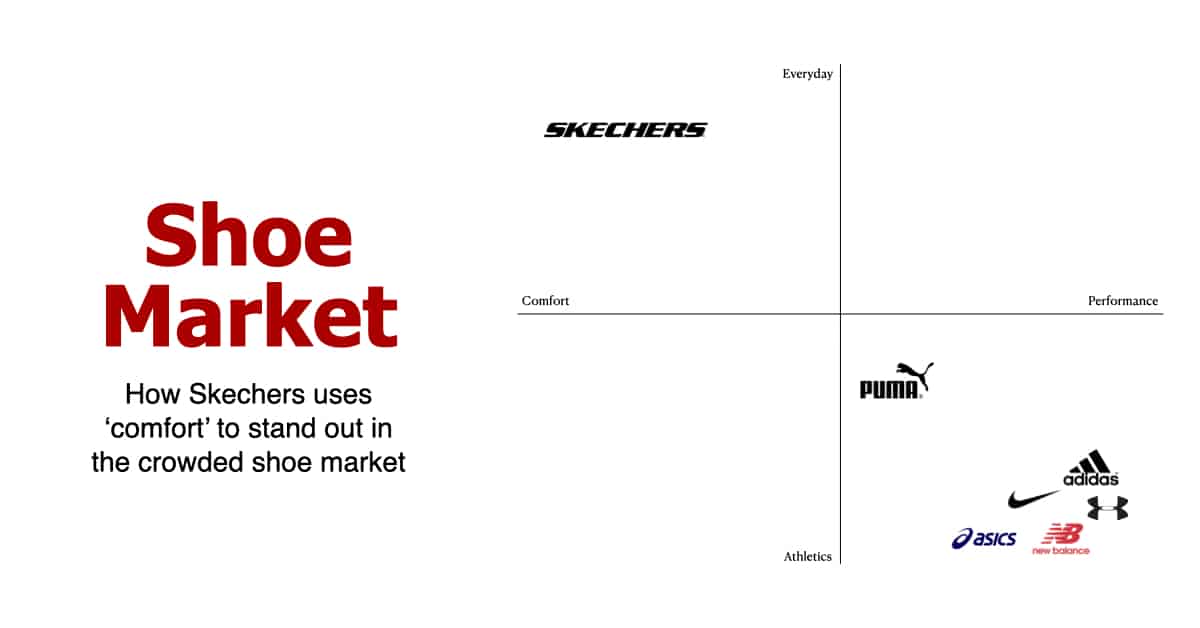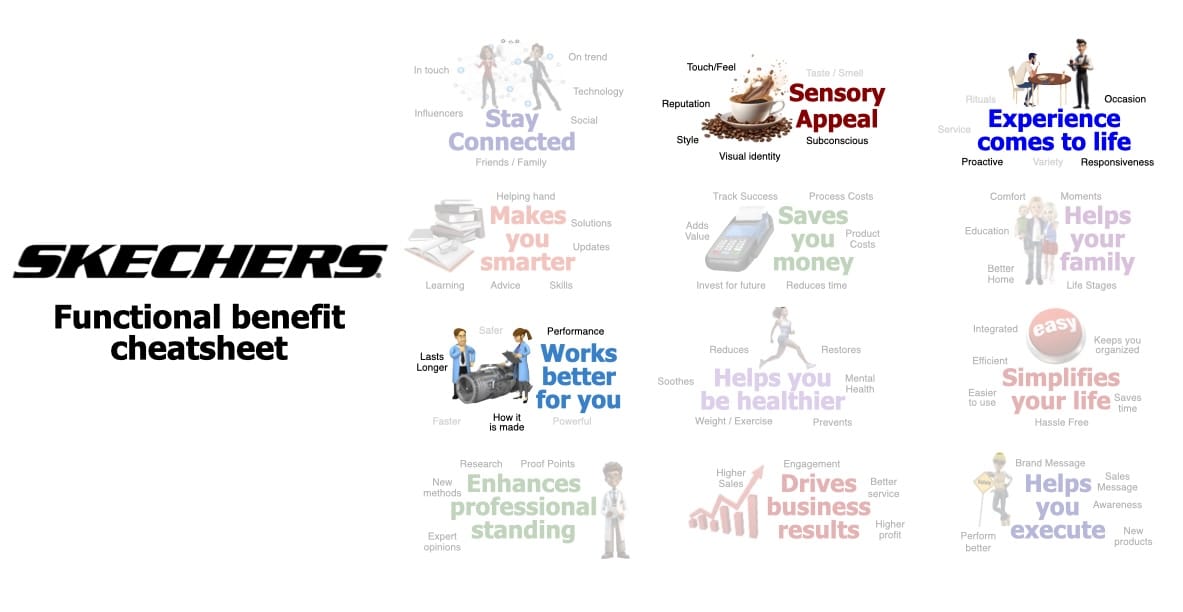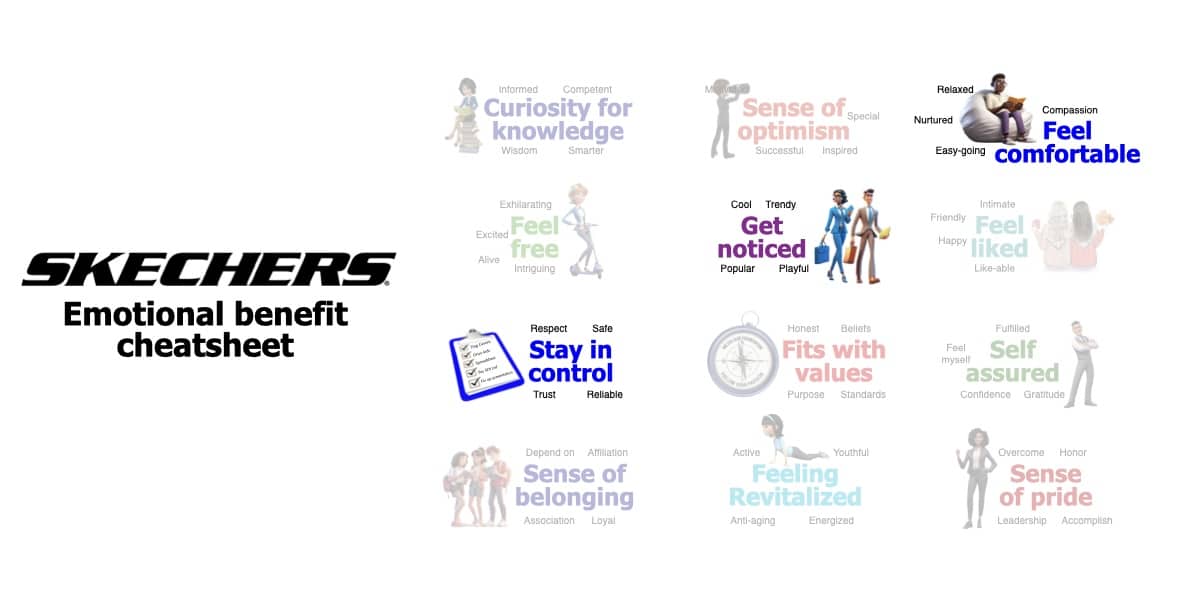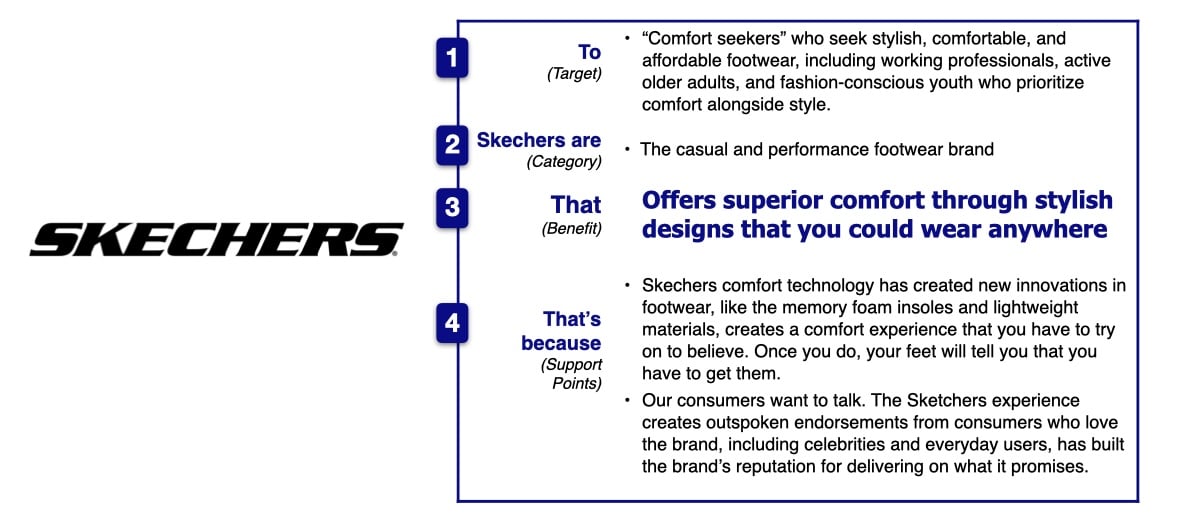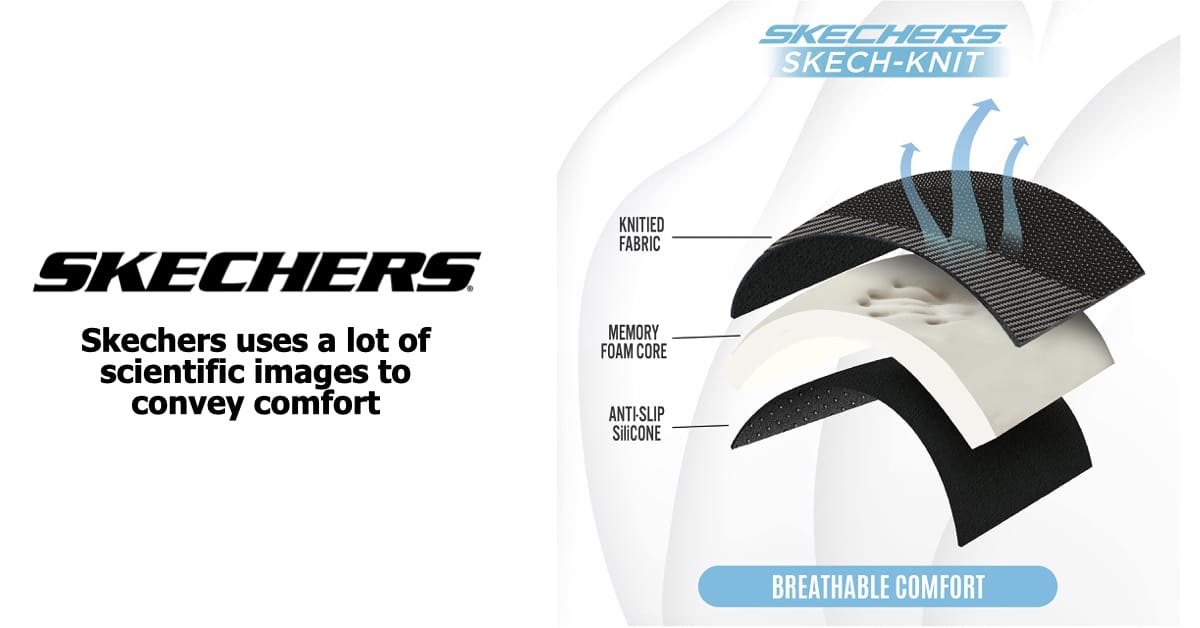I am a big fan of the Skechers brand. I wear them all the time. And yes, I wear their slip-ins for walking the dog, dress shoes for fancy events, and I even have their golf shoes. My wife got me hooked. She said, “You have to try these shoes.” Within seconds, I was set. No shoe is more comfortable. As someone who stands at the front of the room for 8 hours straight, I need comfort. As we proceed with our Skechers Case Study, we’ll dissect the elements of Skechers’ brand strategy, offering insights into how it has become a beloved brand worldwide.
Over the last 30 years, the Skechers brand has grown from a small utility boot company to the third-largest athletic footwear brand in the United States. Its journey is a testament to strategic brand positioning, innovation, and an unwavering commitment to customer satisfaction. By offering a diverse product line that caters to various consumer needs, from lifestyle to performance footwear, Skechers has successfully positioned itself as a brand for everyone.
While the Skechers brand uses B-list celebrity endorsements, they maintain a strong social media presence. The brand is a product-experience brand based on comfort beyond what the consumer could ever expect. You have to try them on to believe them. Moreover, the comfort brand positioning has earned the Skechers brand a place in the hearts of its customers.
Our Skechers case study will explore how the Skechers brand has navigated the competitive footwear industry to build a brand that consumers genuinely love. We will examine its product innovation, brand positioning, and retail engagement approach. Moreover, we explain how Skechers has won market share and built lasting emotional connections with its brand fans.
Skechers Case Study - Table of Contents
Breaking down the shoe market
The top five shoe brands in the US in terms of popularity and market impact are Nike, Adidas, Skechers, ASICS, and Puma. Below, you can see a simple brand positioning map. Most of those brands compete in the performance-athletics space.
Yes, you can wear any of those shoe brands for other things. But the inspiration is rooted in running, basketball, football, or soccer. This leaves a wide open space for Skechers to own the comfort market for everyday use.
To illustrate, click on the Skechers Case Study image above for more details.
Top 10 shoe brands in the US market
Nike:
- First, Nike is the market share leader in the footwear industry due to its extensive product range and strong brand identity. Moreover, Nike is renowned for its innovation in athletic footwear, high-quality products, and strong marketing campaigns. They emphasize performance and style.
Adidas:
- Next, Adidas is the challenger and a close competitor to Nike. It is known for its significant global presence and broad consumer base. Adidas offers a blend of performance and style, focusing on technology and sustainability. The brand is respected for its quality sports gear and lifestyle products.
Skechers:
- Skechers has carved out a significant niche in the market, focusing on comfortable and stylish footwear. With its diverse range of products, which include casual wear and performance footwear, Skechers appeals to a broad demographic.
ASICS:
- ASICS is recognized for its specialization in athletic shoes, particularly in the running segment. As well, ASICS focuses on performance and innovation, with advanced technologies like its Gel cushioning system to enhance the comfort and effectiveness of its footwear.
Puma:
- Puma is known for its fashionable, performance-oriented products. Essentiallly, Puma combines sports and fashion, offering stylish, high-performance footwear and apparel that appeal to athletes and fashion enthusiasts.
Vans:
- Known for its iconic skateboarding shoes, Vans strongly appeals to the lifestyle and youth culture markets.
New Balance:
- New Balance on running shoes and athletic wear, known for emphasizing fit and performance. Similar to ASICS, they focus on running over the other sports.
Under Armour:
- Initially, Under Armour is renowned for its high-performance sports apparel. Then, they expanded significantly into the footwear market, focusing on athletic shoes.
Converse:
- Famous for their Chuck Taylor All-Stars, Converse offers a blend of classic style and casual footwear that appeals to various age groups.
Timberland:
- Timberland is best known for its rugged and durable boots. As well, they offer a range of shoes and outdoor gear, emphasizing durability and environmental responsibility.
Digging into the Skechers Brand Positioning
Four elements make up a brand positioning statement.
To start, define who you will serve (consumer target). Then, define where you will play (category) and where you will win (main benefit statement). Next, to back up your main benefit, use support points to explain why consumers should believe you (reason to believe).
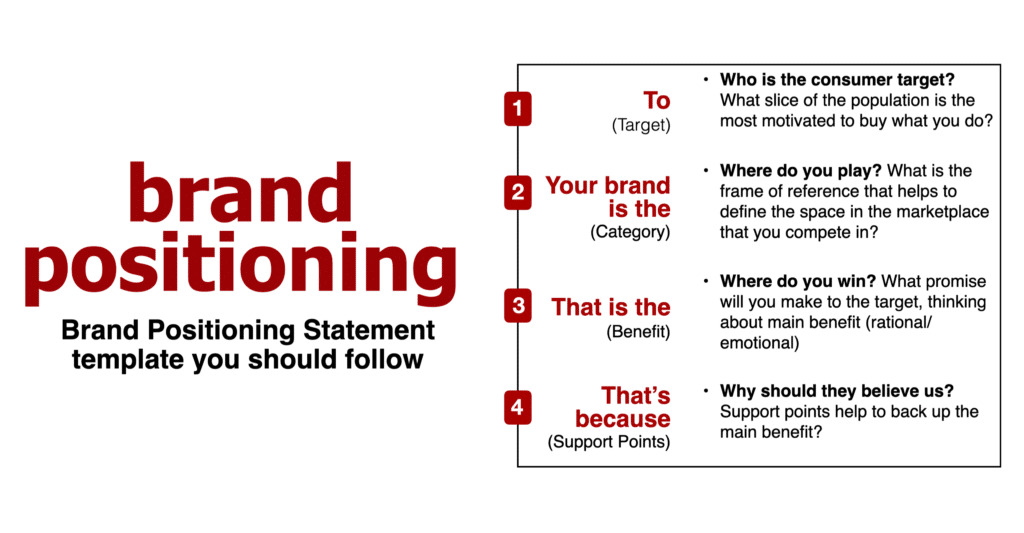
To illustrate, click on the image above for more details.
1️⃣ Who is the consumer target?
First, define a slice of the population most motivated by what your brand offers. However, don’t just think about who you want but who wants your brand.
2️⃣ Where will you play?
Next, consider the competitive set that defines the space in the market your brand competes in. Brand positioning is always relative to who you compete against. For instance, a brand is never fast. It should be faster.
3️⃣ Where will you win?
What is the central promise you will make to the consumer target? It should differentiate your brand to be interesting, simple, unique, motivating, and ownable. Do not talk about what you do. (Features) Instead, talk about what the consumer gets (functional benefits). And talk about how the brand makes them feel. (emotional benefits)
4️⃣ Why should they believe us?
Finally, lay out the support points and features needed to support the main promise. After hearing the main promise, these support points should address any potential doubts, questions, or concerns the consumer has.
The functional benefits for Skechers
To help brand leaders, I have taken twelve functional benefit zones and expanded the list to over 50 potential functional benefits your brand can build around.
Our functional benefits zones include helping consumers stay connected, making them smarter, saving money, simplifying life, helping them be healthier, helping their family, providing sensory appeal, helping their experience come to life, working better, enhancing their professional standing, driving business results, and helping execute.
As you look through the list, gravitate to 2-3 of the functional benefit zones you think will fit the needs of your consumers and where your brand can do it better than competitors.
Start with the words on the cheatsheet below. Then, layer in your creative language based on specific category words or specific consumer words and phrases they use.
Skechers functional benefit zones
To start our Sketchers Case Study, explore the functional benefit zones in the context of the Skechers brand. This brand focuses on the sensory appeal of its shoes, bringing the experience to life. It also emphasizes improved performance to describe its comfort. To see this in action, click on the diagram below.
To illustrate, click on the Skechers Case Study image above for more details.
The emotional benefits of the Skechers brand
From my experience, marketers are adept at identifying the ideal rational benefits for their brands. They often struggle to uncover the ideal emotional benefits. Importantly, it’s crucial for a brand to not only own a rational space in the consumer’s mind. But also establish a strong emotional connection in the consumer’s heart. This is where our emotional benefits tool can be invaluable.
When I push brand managers to get emotional, they struggle and opt for what they view as obvious emotions, even if they do not fit with their brand. Essentially, every brand manager thinks their brand should be trusted, reliable, and likable. Use our cheat sheet to dig deeper into emotions.
Our emotional cheat sheet is a comprehensive tool that covers twelve distinct emotional consumer benefit zones. These zones, which include knowledge, control, comfort, self-assured, optimism, feel myself, liked, freedom, get noticed, sense of belonging, revitalized, and pride, provide a wide spectrum of emotional benefits for brands to explore.
The emotional benefit zones for Skechers
Below is the emotional benefit cheatsheet for the Skechers brand. The obvious zone is comfort, but they also play in the stay-in-control zone for those whose feet grow tired at the end of the day. Finally, they layer in getting noticed with stylish designs that you can wear your Skechers anywhere you go. You can wear them to work, on a date, or on a casual walk. To illustrate, click on the diagram below.
To illustrate, click on the Skechers Case Study image above for more details.
Putting the Skechers brand positioning statement together
For ‘comfort-seeking’ consumers who need everyday footwear that provides both comfort and style, Skechers is the footwear brand that delivers innovative comfort technology in a range of trendy styles at great value. Unlike other lifestyle and sports footwear brands, Skechers provides a unique combination of comfort and style, which creates outspoken brand fans who will try to convince you to try them.
To illustrate, click on the Skechers Case Study image above for more details.
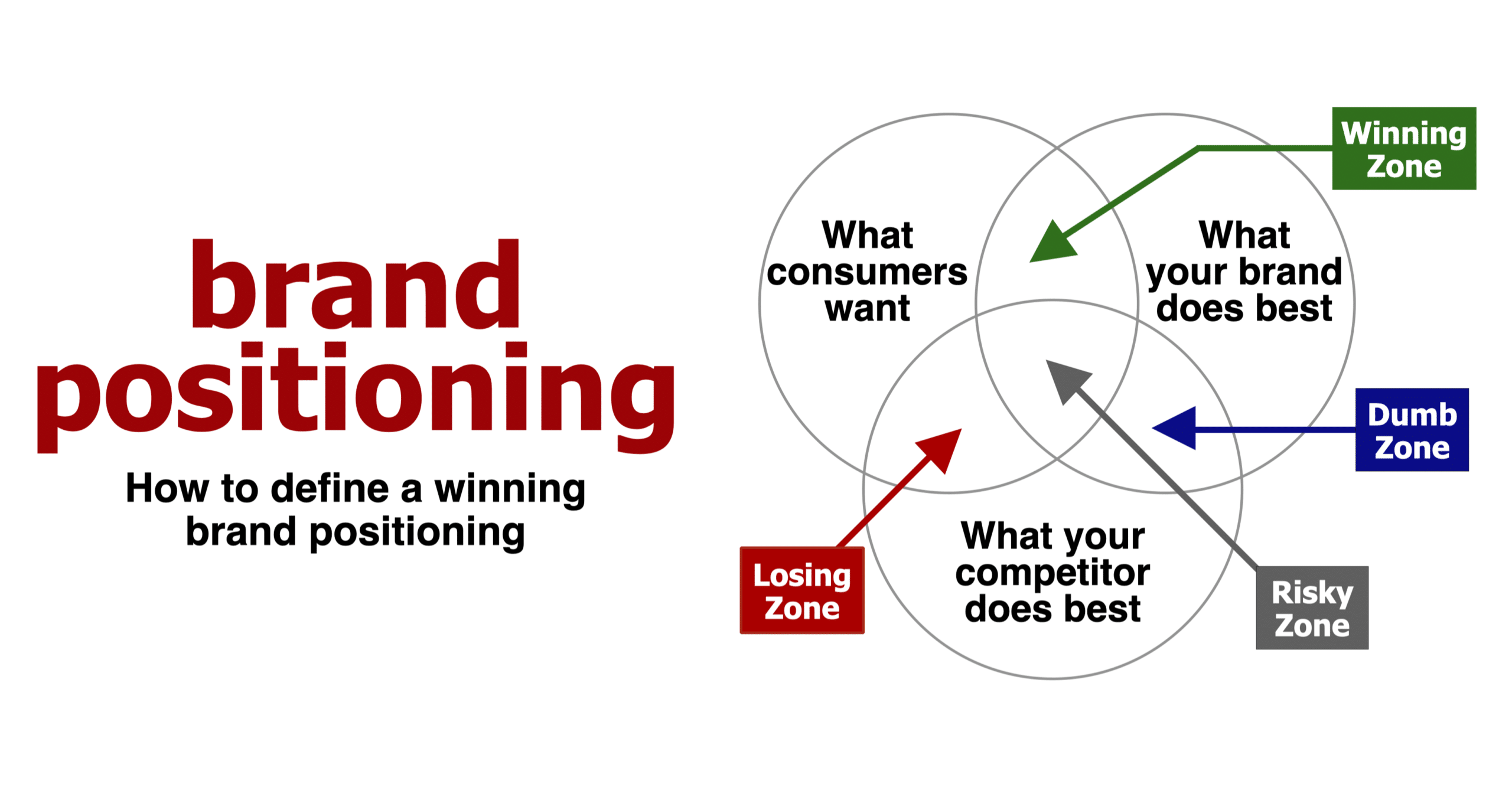
Skechers is now the comfort technology company
Skechers rebranded itself as “The Comfort Technology Company” in 2021. This rebranding was part of their strategy to emphasize their innovative approach to designing comfortable footwear using various advanced technologies. This shift was reflected in their marketing and product development, highlighting their focus on comfort and performance across their collections.

At the heart of Skechers’ brand lies an unwavering dedication to comfort, positioning it as the cornerstone of everything the company does. It reminds me of Volvo’s commitment to safety.
As a product-led brand, Skechers has mastered owning the “comfort” position within the footwear category, distinguishing itself through continuous innovation and a relentless pursuit of category leadership. The brand’s journey from a modest start-up to a global powerhouse in the athletic footwear market is a testament to its ability to exceed consumer expectations for comfort and quality.
Skechers’ strategy is grounded in the principles that define successful product-led brands. They continuously invest heavily in new comfort technology, product development, and superiority claims that bring comfort to life.
The brand’s mass communication efforts are meticulously designed to highlight its footwear’s superior comfort and technical features. Through direct comparisons and clear articulation of product benefits, Skechers’ marketing narratives underscore the tangible advantages of choosing their products over others. This rational approach is complemented by storytelling that reveals the intricate process behind the creation of each shoe, weaving the brand’s dedication to comfort into its broader narrative.
Skechers advancements using comfort technology
Skechers frequently highlights several key claims about comfort. Here are five notable claims often made by Skechers about the comfort of their products:
Memory Foam Cushioning:
Skechers often touts memory foam insoles in their footwear, which adapt to the wearer’s foot shape for personalized daily comfort.
Air-Cooled Technology:
Many Skechers shoes feature air-cooled memory foam technology, which provides the comfort of traditional memory foam and includes breathability features to keep feet cool and comfortable, even in warm conditions.
Lightweight Construction:
Skechers emphasizes the lightweight construction of its shoes, ensuring that they provide comfort without weighing the wearer down, making them ideal for extended wear.
Flexible Sole Design:
The brand highlights the flexible sole design in many of its models. This design promotes a more natural walking experience by adapting to the wearer’s foot movements, enhancing comfort with every step.
Shock Absorption:
Skechers include advanced shock absorption features in their footwear, aimed at reducing the impact on the feet and joints during walking or running, enhancing overall comfort for active users.
These comfort-related claims are integral to Skechers’ brand messaging, underlining its commitment to delivering superior comfort and support across its wide range of footwear options.
To illustrate, click on the Skechers Case Study image above for more details.
Skechers Retail Stores bring the comfort experience to life
Skechers’ retail stores have been a significant driver of its success, showcasing a substantial increase in both sales and market presence over recent years. The brand has adapted to market demands, achieving notable growth in its direct sales through physical stores and its e-commerce platform.
To illustrate, click on the Skechers Case Study image above for more details.
Comfort Experience in Skechers Retail Stores
Skechers retail stores are meticulously designed to enhance consumer experience, offering a wide range of footwear and apparel that underscores comfort, style, innovation, and quality. The stores are organized into three unique formats:
- First, Concept Stores are placed in high-traffic destinations to attract a broad audience.
- Second, Outlet Stores aim to reach consumers looking for value in premium centers.
- Finally, Superstores offer a large-format shopping experience with dedicated collection shops for efficient product movement.
This strategic store layout, designed with the consumer at its core, ensures that every interaction is optimized for product discovery and engagement. By focusing on diverse consumer bases, Skechers aims to make every shopper feel catered to, ensuring they find products that meet their style and functional needs.
The brand’s focus on comfort is palpable within the store environment, allowing consumers to experience the comfort technologies Skechers shoes offer, such as memory foam insoles and flexible shoe designs.
Digital and Direct-to-Consumer Strategies
Skechers has also significantly invested in its digital strategy to enhance the consumer experience further.
First, Skechers re-platforms their e-commerce sites to provide a seamless online shopping experience. They use loyalty programs to foster customer retention and engagement.
Second, these initiatives are part of Skechers’ broader global strategy to become a leading direct-to-consumer retailer. They leverage their digital platforms to complement the physical retail experience.
Overall, Skechers’ success in retail is not just about selling shoes but creating an environment where consumers can directly experience the brand’s value proposition. Their strategic retail formats, coupled with a strong digital presence, enable Skechers to meet diverse consumer needs effectively and maintain a strong growth trajectory in the competitive footwear market.

Brand Management Mini MBA
Time to invest in your future.
If you are an ambitious marketer looking to solidify your marketing skills, our Brand Management Mini MBA will teach you about strategic thinking, brand positioning, brand plans, advertising decisions, and marketing analytics. Moreover, we designed our Mini MBA program to help you in your marketing career.
Have a look at our brochure on our Mini MBA program
To illustrate, use > to move through the brochure or x to see the full screen.
What is included in our Mini MBA program
You get 36 training videos and key chapters from our Beloved Brands Playbook. To learn more, we include a Brand Management Workbook with exercises to try in real-time. Importantly, you will earn a certificate you can use on your resume or LinkedIn profile.



